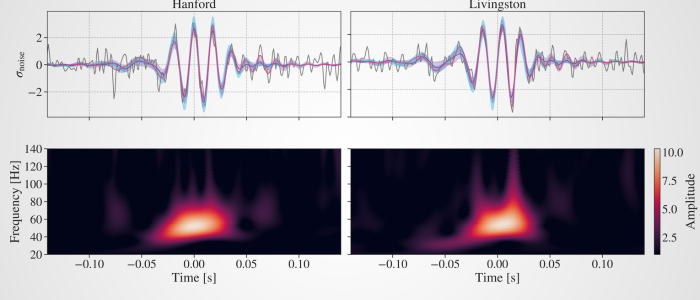Black holes discovery to be revealed at gravitational waves conference in Glasgow
Published: 14 July 2025
The most massive black holes ever observed with gravitational waves have been discovered by scientists, with some of the analyses carried out by an international team that was led by an astrophysicist at the University of Glasgow.

The most massive black holes ever observed with gravitational waves have been discovered by scientists, with some of the analyses carried out by an international team that was led by an astrophysicist at the University of Glasgow.
The LIGO-Virgo-KAGRA (LVK) Collaboration said the detection of the merger of the two black holes was made using the US National Science Foundation-funded (NSF) LIGO Hanford and Livingston Observatories.
Details of signal GW231123 will be presented at the 24th International Conference on General Relativity and Gravitation (GR24) and the 16th Edoardo Amaldi Conference on Gravitational Waves, held jointly as the GR-Amaldi meeting in Glasgow - the largest gathering of gravitational waves scientists in the world, which starts today (July 14-18 2025).
The announcement and conference come ahead of the 10th anniversary of the historic first detection of gravitational waves – a groundbreaking discovery which established a new field of astronomy.
The newly-revealed massive merger produced a final black hole more than 225 times the mass of our Sun. The signal was observed during the fourth observing run (O4) of the LVK network on November 23, 2023.
The two black holes that merged were approximately 100 and 140 times the mass of the Sun. In addition to their high masses they are also rapidly spinning, making this a uniquely challenging signal to interpret and suggesting the possibility of a complex formation history.
“This is the most massive black hole binary we’ve observed through gravitational waves, and it presents a real challenge to our understanding of black hole formation,” said Professor Mark Hannam, from Cardiff University and a member of the LIGO Scientific Collaboration.
“Black holes this massive are forbidden through standard stellar evolution models. One possibility is that the two black holes in this binary formed through earlier mergers of smaller black holes.”
Approximately 100 black-hole mergers have previously been observed through gravitational waves. Until now the most massive binary was the source of GW190521, with a much smaller total mass of ‘only’ 140 times that of the sun.
University of Glasgow researchers made leading contributions to the UK’s role in the LIGO Scientific Collaboration, developing the delicate mirror suspensions which made the detection possible, and have played key roles in data analysis and detector design improvements.
Dr Daniel Williams, a research associate at the Institute for Gravitational Research within the University’s School of Physics & Astronomy, leads the team within the LVK which was responsible for performing the analysis which allows scientists to understand the physical properties of the black holes which produced the signals.
He said: “Since making our first detection of gravitational waves from a pair of colliding black holes in 2015, we've become very good at finding and understanding these exotic astrophysical phenomena. This exciting event is one of many which we've analysed from data collected in 2023 and early 2024, and it's an excellent example of how we're still discovering new and unexpected things about black holes and ultimately about how stars evolve."
The high mass and extremely rapid spinning of the black holes in GW231123 pushes the limits of both gravitational-wave detection technology and current theoretical models. Extracting accurate information from the signal required the use of theoretical models that account for the complex dynamics of highly spinning black holes.
Researchers are continuing to refine their analysis and improve the models used to interpret such extreme events. "It will take years for the community to fully unravel this intricate signal pattern and all its implications" states Dr Gregorio Carullo, Assistant Professor at the University of Birmingham. "Despite the most likely explanation remaining a black hole merger, more complex scenarios could be the key to deciphering its unexpected features. Exciting times ahead!"
Gravitational-wave detectors such as LIGO in the United States, Virgo in Italy, and KAGRA in Japan are designed to measure minute distortions in spacetime caused by violent cosmic events like black hole mergers. The fourth observing run began in May 2023 and observations from the first half of the run (up to January 2024) will be published later in the summer.
LIGO is funded by the U.S. National Science Foundation (NSF) and operated by Caltech (California Institute of Technology) and MIT (Massachusetts Institute of Technology), which conceived and built the project.
“This event pushes our instrumentation and data-analysis capabilities to the edge of what’s currently possible,” says Dr Sophie Bini, a postdoctoral researcher at Caltech. “It’s a powerful example of how much we can learn from gravitational-wave astronomy—and how much more there is to uncover.”
Title image: GW231123 signal in data from the LIGO Hanford (left) and Livingston (right) detectors. The top panels show the amplitude of the data over time (grey traces). The shaded blue band shows an estimate of the true signal. The bottom panels are spectrograms, also known as time-frequency maps, which show the signal amplitude over time (horizontal axis) and across frequencies (vertical axis). Brighter colors represent a stronger signal.
First published: 14 July 2025

